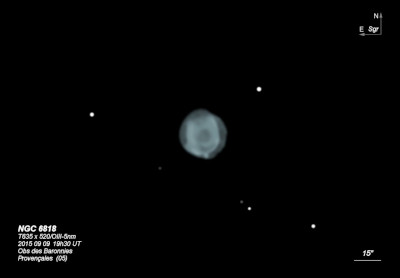Little Gem Nebula
Little Gem Nebula

William Herschel discovered NGC 6818 = H IV-51 = h2047 on 8 Aug 1787 (sweep 749) and recorded "a small beautiful planetary nebula, but considerably hazy upon the edges; it is of uniform light throughout, considerably bright. Perfectly round, 10 or 15" in diameter. My brother Jacob being in the gallery, I showed it to him." His position was very accurate.
John Herschel reported that "It is exactly like a planet and two satellites. Distance of A, the nearer, 20", Pos 45° np; of B, 25", 20° nf." JH was interested in the idea that in some cases PN were accompanied by satellites (NGC 6905 and NGC 7662 are two other examples he mentioned). Other astronomers, such as Olbers, were also interested in this notion.
On 28 Aug 1850, Lord Rosse (or his assistant) recorded, "vB, blue planetary neb, edges not sharp, a little darker in the middle." A year later, assistant Bindon Stoney logged "the dark part is a little np middle." In 1856 Father Secchi noted (and sketched) a darker center in the shape of a cross using a 9.5" refractor at 1000x.
Based on Crossley photographs at Lick, Curtis (1918) wrote "A rather irregular oval ring 22"x15" in p.a. 10°, fainter along and at the ends of the major axis. A fainter narrow ring shows at east and west outside of the inner bright ring."
John Mallas coined the nickname "Little Gem" in the Jun/Jul 1963 article "Visual Atlas of Planetary Nebulae-V", published in the "Review of Popular Astronomy". He noted it was "the bluest of the planetaries I have observed."
300/350mm - 13.1" (9/3/83): very bright, slightly elongated N-S, fairly small.
400/500mm - 17.5" (7/12/99): at 100x this striking PN is bright and small with an obvious blue color. The high surface brightness easily allows high power. At 380x, there is subtle but obvious structure with a darker center and an irregular brightness to the halo. Most noticeably the PN is brighter on the east end and mildly annular. Appears slightly elongated N-S, ~20"x15" in size. Three mag 13-13.5 stars are nearby at 40" NW, 1.0' E and 1.3' SW.
17.5" (7/16/88): at 412x appears very bright, fairly small, slightly elongated N-S, blue color, very high surface brightness. Appears brighter along the east side and slightly brighter along the west side compared to the center. Has a darker elongated center but the annularity has a pretty low contrast. Barnard's galaxy NGC 6822 lies 40' SSE.
600/800mm - 24" (8/25/19): viewed at 375x, 500x, 644x, and 1000x; easily takes high power due to its high surface brightness and good seeing. The annular structure, though only moderate contrast, was very interesting with a relatively large, oval darker center and a very irregular, relatively narrow ring with an irregular surface brightness (brighter spots). The edge was soft in sections with a strong impression of a thin faint halo.
24" (7/19/17): at 375x, 500x, 750x and 1000x: small, very high surface brightness oval, slightly elongated N-S, with a blue color at 375x, takes up to 1000x! The planetary is encased in a thin outer shell. Occasionally the center seemed to sharpen to a point, but I couldn't confirm the central star with confidence. The rim seemed to sparkle with slightly brighter regions. Located 40' N of Barnard's Galaxy (NGC 6822).
Notes by Steve Gottlieb